How Long Are the Wildfires Expected to Continue
This indicator tracks the frequency, extent, and severity of wildfires in the United States.
-
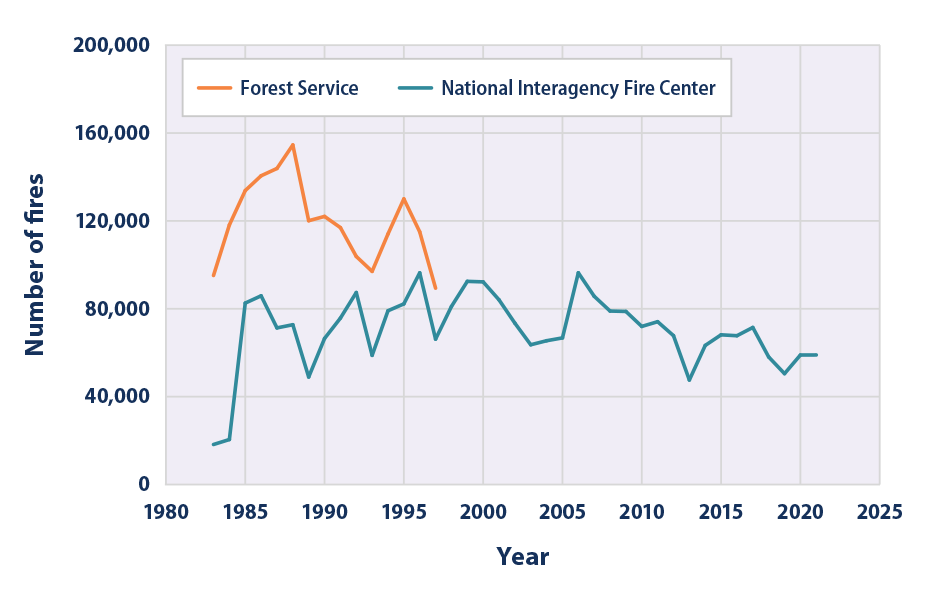
This figure shows the total number of wildfires per year from 1983 to 2021. These totals include all reported wildfires, which can be as small as just a few acres. The two lines represent two different reporting systems; though the Forest Service stopped collecting statistics (orange line) in 1997 and will not update them, those statistics are shown here for comparison.
Data source: NIFC, 2022;21 USDA Forest Service, 201422
Web update: July 2022 -
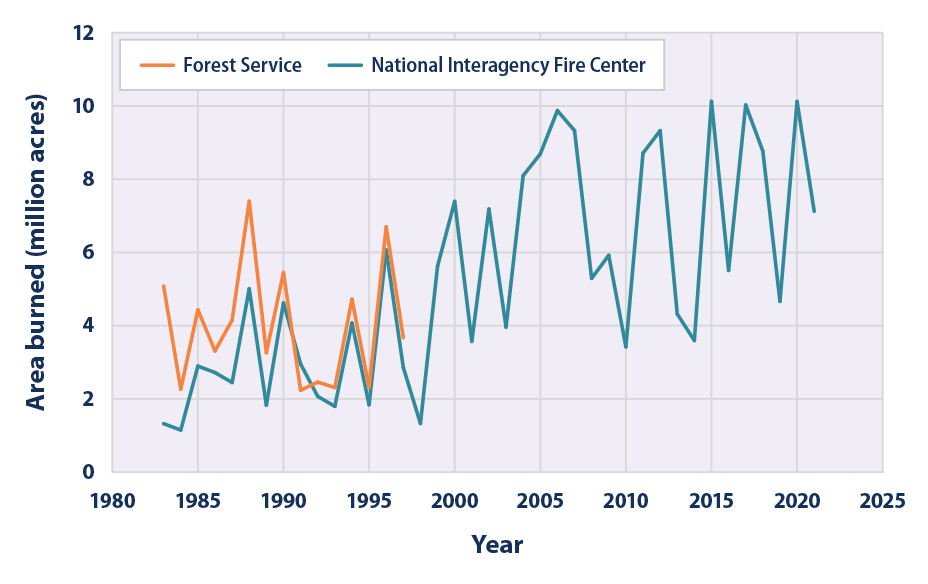
This figure shows annual wildfire-burned area (in millions of acres) from 1983 to 2021. The two lines represent two different reporting systems though the Forest Service stopped collecting statistics (orange line) in 1997 and is not planning to update them, those statistics are shown here for comparison.
Data source: NIFC, 2022;23 Short, 201524
Web update: July 2022 -
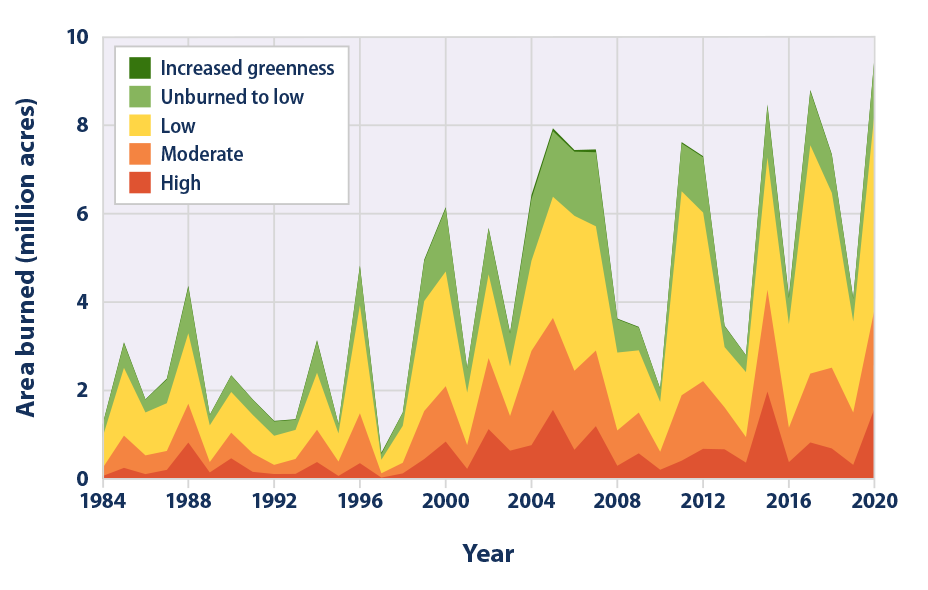
This figure shows the distribution of acreage burned by large wildfires, based on the level of damage caused to the landscape—a measure of wildfire severity. Large wildfires are defined as fires with an area larger than 1,000 acres in the western United States and 500 acres in the eastern United States. The total acreage shown in Figure 3 is slightly less than the total in Figure 2 because Figure 3 is limited to large fires and because a few areas did not have sufficient satellite imagery to allow damage to be assessed.
Data source: MTBS, 202225
Web update: July 2022 -
This map shows the average number of acres burned in each state per year as a proportion of that state's total land area. Darker-shaded states have the largest proportion of acreage burned. Click each state to reveal the data. For reference, there are 640 acres in a square mile; therefore, an average burned area of 6.4 acres per square mile would mean that fires burned 1 percent of a state's total land area. A few states did not have any fires that were large enough to be included in this analysis.
Data source: MTBS, 202226
Web update: July 2022 -
This map shows how the number of acres burned in each state as a proportion of that state's total land area has changed over time, based on a simple comparison between the first half of the available years (1984–2001) and the second half (2002–2020). Click each state to reveal the data. For reference, there are 640 acres in a square mile; therefore, a change of 6.4 acres per square mile would mean that burned area increased by 1 percent of a state's total land area. A few states did not have any fires that were large enough to be included in this analysis.
Data source: MTBS, 202227
Web update: July 2022 -
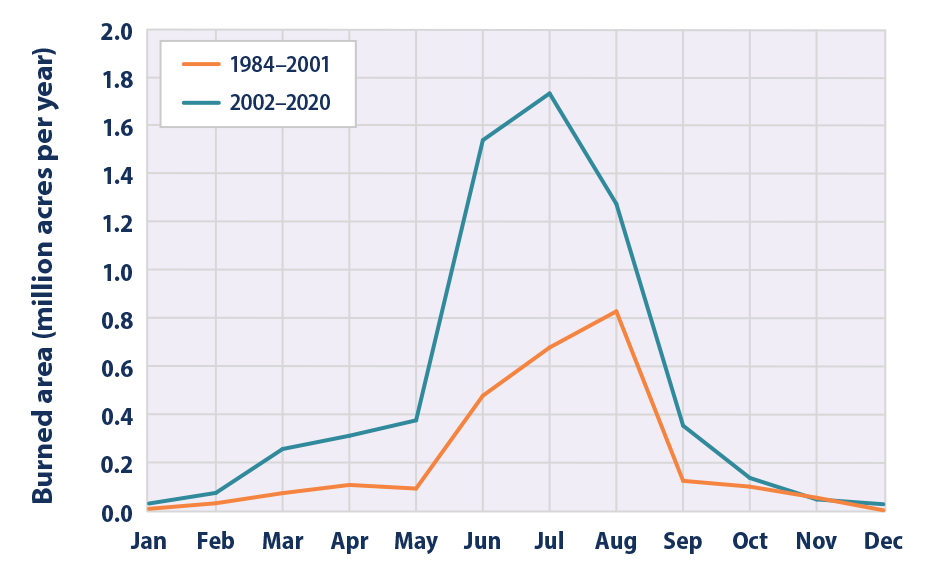


This figure compares the annual distribution of burned area due to wildfires in the United States between the first half of the period of measurement (1984–2001) and the second half (2002–2020).
Data source: MTBS, 202228
Web update: July 2022 -
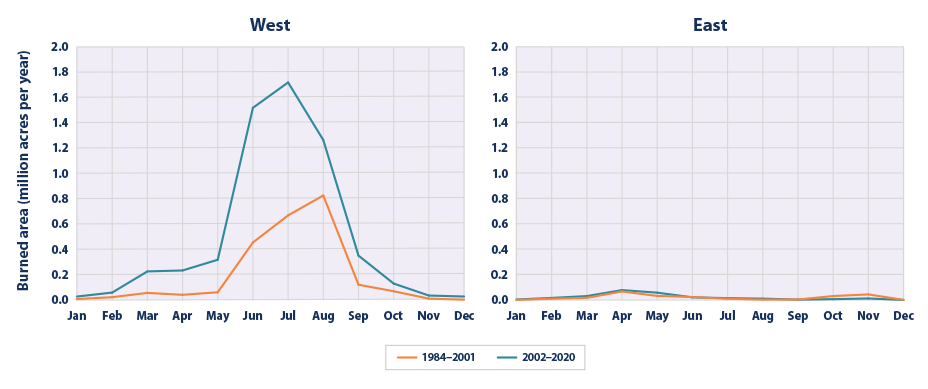


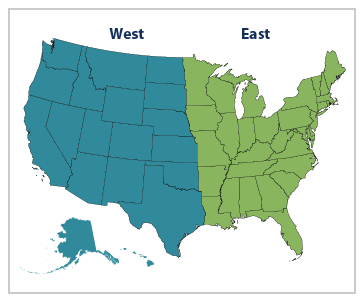 This figure compares the annual distribution of burned area due to wildfires in the eastern and western United States between the first half of the period of measurement (1984–2001) and the second half (2002–2020).
This figure compares the annual distribution of burned area due to wildfires in the eastern and western United States between the first half of the period of measurement (1984–2001) and the second half (2002–2020).Data source: MTBS, 202229
Web update: July 2022
Key Points
- Since 1983, the National Interagency Fire Center has documented an average of approximately 70,000 wildfires per year (see Figure 1). Compiled data from the Forest Service suggest that the actual total may be even higher for the first few years of nationwide data collection that can be compared. The data do not show an obvious trend during this time.
- The extent of area burned by wildfires each year appears to have increased since the 1980s. According to National Interagency Fire Center data, of the 10 years with the largest acreage burned, all have occurred since 2004, including the peak year in 2015 (see Figure 2). This period coincides with many of the warmest years on record nationwide (see the U.S. and Global Temperature indicator). The largest increases have occurred during the spring and summer months (see Figure 6).
- The late 1990s were a period of transition in certain climate cycles that tend to shift every few decades.18 This shift—combined with other ongoing changes in temperature, drought, and snowmelt—may have contributed to warmer, drier conditions that have fueled wildfires in parts of the western United States.19,20
- Of the total area burned each year from 1984 to 2020, the proportion of burned land suffering severe damage has ranged from 5 to 23 percent (see "high" category in Figure 3).
- Land area burned by wildfires varies by state. Fires burn more land in the western United States than in the East, and parts of the West and Southwest show the largest increase in burned acreage between the first half of the period of record in Figures 4 and 5 (1984–2001) and the second half (2002–2020). Burned acreage in the West has increased noticeably in nearly every month of the year (see Figure 7).
- The peak of the U.S. wildfire season is occurring earlier (see Figure 6). In 1984–2001, burned area peaked in August. More recently, it has peaked in July. An average of 1.7 million acres burned in July of each year from 2002 to 2020.
Background
Together, forests, shrubland, and grassland cover more than half of the land area in the United States.1 These ecosystems are important resources, both environmentally and economically. Although wildfires occur naturally and play a long-term role in the health of these ecosystems, changing wildfire patterns threaten to upset the status quo. Multiple studies have found that climate change has already led to an increase in wildfire season length, wildfire frequency, and burned area.2, 3 The wildfire season has lengthened in many areas due to factors including warmer springs, longer summer dry seasons, and drier soils and vegetation.4 Similarly, climate change threatens to increase the frequency, extent, and severity of fires through increased temperatures and drought (see the U.S. and Global Temperature and Drought indicators).5 Earlier spring melting and reduced snowpack (see the Snowpack indicator) result in decreased water availability during hot summer conditions, which in turn contributes to an increased wildfire risk, allowing fires to start more easily and burn hotter. These trends of longer wildfire seasons and larger wildfire size are predicted to continue as more frequent and longer droughts occur.6 In addition to climate change, other factors—land use, large-scale insect infestation, fuel availability (including invasive species such as highly flammable cheatgrass), and management practices, including fire suppression—play an important role in wildfire frequency and intensity. All of these factors influencing wildfires vary greatly by region and over time, as do precipitation, wind, temperature, vegetation types, and landscape conditions. Therefore, understanding changes in fire characteristics requires long-term records, a regional perspective, and consideration of many factors.7
Wildfires have the potential to harm property, livelihoods, and human health. Fire-related threats are increasing, especially as more people live in and around forests, grasslands, and other natural areas.8 According to the National Oceanic and Atmospheric Administration, between 1980 and 2021 the United States had 20 wildfire events that caused more than $1 billion in damage; 16 of those have occurred since 2000.9 Over the past few decades, the United States has routinely spent more than $1 billion per year to fight wildfires, including $2.3 billion in 2020.10 These efforts have resulted in the deaths of more than 1,000 firefighters since 1910.11 Even in communities far downwind, wildfire smoke has been directly linked to poor air quality that can lead to significant health effects and costs to society (emergency department visits, hospital admissions, and deaths, often due to respiratory ailments).12, 13, 14, 15, 16
Beyond the human and societal impacts, wildfires also affect the Earth's climate. Forests in particular store large amounts of carbon. When they burn, they immediately release carbon dioxide into the atmosphere, which in turn contributes to climate change. After burning, forests also release carbon dioxide more gradually through decomposition.
About the Indicator
This indicator defines a wildfire as "a wildland fire originating from an unplanned ignition, such as lightning, volcanos, unauthorized and accidental human caused fires, and prescribed fires that are declared wildfires."17 This indicator tracks four aspects of wildfires over time: the total number of fires (frequency), the total land area burned (extent), the degree of damage that fires cause to the landscape (severity), and the acreage burned by fires starting in each month of the year (seasonal patterns).
The total area and total number of fires are tracked by the National Interagency Fire Center, which compiles reports from local, state, and federal agencies that are involved in fighting wildfires. The U.S. Forest Service tracked similar data using a different reporting system until 1997. Those data have been added to this indicator for comparison. Burn severity, state-level acreage, and monthly totals are based on data from the Monitoring Trends in Burn Severity (MTBS) project, which provides the location, ignition date, size, and other statistics for every individual wildfire that meets certain size criteria (≥ 1,000 acres in the western United States or ≥ 500 acres in the eastern United States). MTBS compares the "greenness" of satellite images taken before and after a fire to classify how severely the land has been burned. Burn severity provides an indication of the ecological damage and how long the effects of wildfires are likely to last.
Although some nationwide fire data have been collected since the early 1900s, this indicator starts in 1983 (Figures 1 and 2) and 1984 (Figures 3 through 7), when nationwide data collection became more complete and standardized. EPA divided the time period in Figures 5, 6, and 7 into two roughly equal halves to compare changes in wildfire characteristics over time.
About the Data
Indicator Notes
Many environmental impacts associated with climate change can affect the severity and timing of the wildfire season, including changes in temperature, precipitation, and drought. Short-term weather conditions (dryness, temperature, wind, lightning) influence the likelihood of ignition, where and how quickly a fire spreads, and how big it gets. Longer-term climate patterns also play a role by creating conditions that may be conducive to wildfire (for example, a multi-year regional drought). Human activities and land management practices also affect wildfire activity, and preferred practices in wildfire management have evolved over time, from older policies that favored complete wildfire prevention to more recent policies of wildfire suppression and controlled burns. Resources available to fight and manage wildfires can also influence the amount of area burned over time.
While this indicator is limited to "wildland" fires, it includes fires that encroach on—or perhaps started in—developed areas. Increased development in previously wild lands could also influence trends in wildfire frequency and extent. The total number of fires may also vary due to reporting irregularities, as fires that split or merge together across jurisdictional lines may be counted differently.
Along with the influence of ongoing climate change, wildfire patterns can be influenced by natural climate cycles that tend to shift every few decades. Thus, with less than four decades of data shown here, it might be challenging to draw conclusions about long-term trends. While a longer record would be ideal, data from before 1983 are not consistent or detailed enough nationally to be included in this indicator.
Data Sources
The full set of wildfire frequency and burned acreage data in Figures 1 and 2 comes from the National Interagency Fire Center, which compiles wildfire reports sent from local, state, and federal entities that are involved in fighting fires. These data are available online at: www.nifc.gov/fire-information/statistics. Additional data were provided by the U.S. Forest Service based on a different set of records, referred to as Smokey Bear Reports. Burn severity data, state-by-state acreage totals, and monthly acreage data in Figures 3 through 7 come from the MTBS multi-agency project, which maintains a database of wildfire events across the United States. These data are publicly available at: www.mtbs.gov/direct-download.
Technical Documentation
- Download related technical information PDF
References
1. MRLC (Multi-Resolution Land Characteristics) Consortium. 2019. National Land Cover Database 2016 (NLCD2016) statistics for 2016. www.mrlc.gov/data/statistics/national-land-cover-database-2016-nlcd2016-statistics-2016.
2. USGCRP (U.S. Global Change Research Program). 2018. Impacts, risks, and adaptation in the United States: Fourth National Climate Assessment, volume II. Reidmiller, D.R., C.W. Avery, D.R. Easterling, K.E. Kunkel, K.L.M. Lewis, T.K. Maycock, and B.C. Stewart (eds.). https://nca2018.globalchange.gov/downloads. doi:10.7930/NCA4.2018.
3. Westerling, A.L. 2016. Increasing western U.S. forest wildfire activity: Sensitivity to changes in the timing of spring. Phil. Trans. R. Soc. B. 371:20150178.
4. USGCRP (U.S. Global Change Research Program). 2018. Impacts, risks, and adaptation in the United States: Fourth National Climate Assessment, volume II. Reidmiller, D.R., C.W. Avery, D.R. Easterling, K.E. Kunkel, K.L.M. Lewis, T.K. Maycock, and B.C. Stewart (eds.). https://nca2018.globalchange.gov/downloads. doi:10.7930/NCA4.2018.
5. USGCRP (U.S. Global Change Research Program). 2017. Climate science special report: Fourth National Climate Assessment, volume I. Wuebbles, D.J., D.W. Fahey, K.A. Hibbard, D.J. Dokken, B.C. Stewart, and T.K. Maycock (eds.). https://science2017.globalchange.gov. doi:10.7930/J0J964J6.
6. USGCRP (U.S. Global Change Research Program). 2018. Impacts, risks, and adaptation in the United States: Fourth National Climate Assessment, volume II. Reidmiller, D.R., C.W. Avery, D.R. Easterling, K.E. Kunkel, K.L.M. Lewis, T.K. Maycock, and B.C. Stewart (eds.). https://nca2018.globalchange.gov/downloads. doi:10.7930/NCA4.2018.
7. Stein, S.M., J. Menakis, M.A. Carr, S.J. Comas, S.I. Stewart, H. Cleveland, L. Bramwell, and V.C. Radeloff. 2013. Wildfire, wildlands, and people: Understanding and preparing for wildfire in the wildland-urban interface. Gen. Tech. Rep. RMRS-GTR-299. Fort Collins, CO: U.S. Department of Agriculture. www.fs.fed.us/openspace/fote/wildfire-report.html.
8. National Association of State Foresters. 2009. Quadrennial fire review. https://www.forestsandrangelands.gov/documents/strategy/foundational/qfr2009final.pdf.
9. NOAA (National Oceanic and Atmospheric Administration). 2022. Billion-dollar weather and climate disasters. Accessed June 2022. www.ncei.noaa.gov/access/billions. doi:10.25921/stkw-7w73.
10. NIFC (National Interagency Fire Center). 2022. Historical wildland fire information: Federal firefighting costs: Suppression only (1985–2020). Accessed June 2022. www.nifc.gov/fire-information/statistics/suppression-costs.
11. NIFC (National Interagency Fire Center). 2019. Wildland fire fatalities by year (1910–2017). Accessed 2019.
12. Johnston, F.H., S.B. Henderson, Y. Chen, J.T. Randerson, M. Marlier, R.S. DeFries, P. Kinney, D. Bowman, and M. Brauer. 2012. Estimated global mortality attributable to smoke from landscape fires. Environ. Health Persp. 120(5):695–701. www.ncbi.nlm.nih.gov/pmc/articles/PMC3346787.
13. Fann, N., T. Brennan, P. Dolwick, J.L. Gamble, V. Ilacqua, L. Kolb, C.G. Nolte, T.L. Spero, and L. Ziska. 2016. Chapter 3: Air quality impacts. In: The impacts of climate change on human health in the United States: A scientific assessment. U.S. Global Change Research Program. https://health2016.globalchange.gov.
14. Youssouf, H., C. Liousse, L. Roblou, E.-M. Assamoi, R.O. Salonen, C. Maesano, S. Banerjee, and I. Annesi-Maesano. 2014. Non-accidental health impacts of wildfire smoke. Int. J. Environ. Res. Public Health 11:11772–11804. www.mdpi.com/1660-4601/11/11/11772. doi:10.3390/ijerph111111772.
15. Jones, B.A., and R.P. Berrens. 2017. Application of an original wildfire smoke health cost benefits transfer protocol to the western U.S., 2005–2015. Environ. Manage. 60:809–822. doi:10.1007/s00267-017-0930-4.
16. Fann, N., B. Alman, R.A. Broome, G.G. Morgan, F.H. Johnston, G. Pouliot, and A.G. Rappold. 2018. The health impacts and economic value of wildland fire episodes in the U.S.: 2008–2012. Sci. Total Environ. 610–611:802–809. doi:10.1016/j.scitotenv.2017.08.024.
17. NWCG (National Wildfire Coordinating Group). 2020. Glossary of wildland fire terminology. Accessed December 2020. www.nwcg.gov/publications/pms205.
18. For example, see: Peterson, W.T., and F.B. Schwing. 2003. A new climate regime in northeast Pacific ecosystems. Geophys. Res. Lett. 30(17).
19. Kitzberger, T., P.M. Brown, E.K. Heyerdahl, T.W. Swetnam, and T.T. Veblen. 2007. Contingent Pacific–Atlantic Ocean influence on multicentury wildfire synchrony over western North America. P. Natl. Acad. Sci. USA 104(2):543–548.
20. Westerling, A.L. 2016. Increasing western U.S. forest wildfire activity: Sensitivity to changes in the timing of spring. Phil. Trans. R. Soc. B. 371:20150178.
21. NIFC (National Interagency Fire Center). 2022. Total wildland fires and acres (1983–2022). Accessed May 2022. www.nifc.gov/fireInfo/fireInfo_stats_totalFires.html.
22. USDA (U.S. Department of Agriculture) Forest Service. 2014. 1991–1997 wildland fire statistics. Prepared by USDA Forest Service, State and Private Forestry, Fire and Aviation Management staff, and supplemented with historical records provided by Forest Service staff, April 2014.
23. NIFC (National Interagency Fire Center). 2022. Total wildland fires and acres (1983–2022). Accessed June 2022. www.nifc.gov/fireInfo/fireInfo_stats_totalFires.html.
24. Short, K.C. 2015. Sources and implications of bias and uncertainty in a century of U.S. wildfire activity data. Int. J. Wildland Fire 24(7):883–891.
25. MTBS (Monitoring Trends in Burn Severity). 2022. Direct download. Accessed June 2022. www.mtbs.gov/direct-download.
26. MTBS (Monitoring Trends in Burn Severity). 2022. Direct download. Accessed June 2022. www.mtbs.gov/direct-download.
27. MTBS (Monitoring Trends in Burn Severity). 2022. Direct download. Accessed June 2022. www.mtbs.gov/direct-download.
28. MTBS (Monitoring Trends in Burn Severity). 2022. Direct download. Accessed April 2022. www.mtbs.gov/direct-download.
29. MTBS (Monitoring Trends in Burn Severity). 2022. Direct download. Accessed April 2022. www.mtbs.gov/direct-download.
Learn about other indicators in this section
Source: https://www.epa.gov/climate-indicators/climate-change-indicators-wildfires
0 Response to "How Long Are the Wildfires Expected to Continue"
Post a Comment